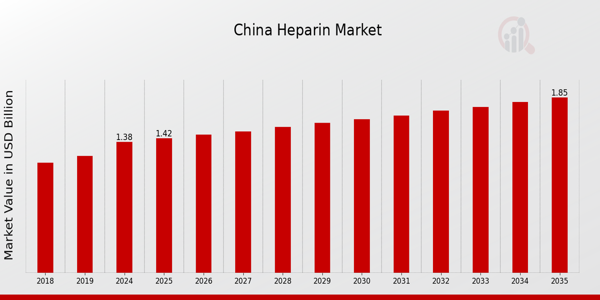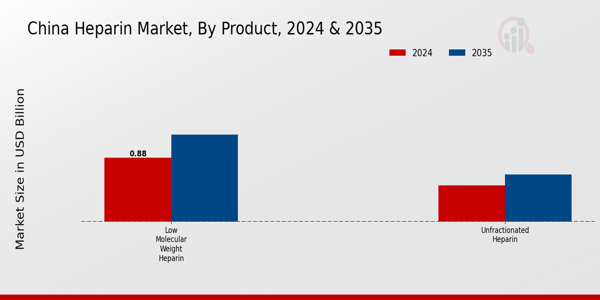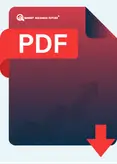China Heparin Market Overview:
As per MRFR analysis, the China Heparin Market Size was estimated at 1.15 (USD Billion) in 2023.The China Heparin Market Industry is expected to grow from 1.38(USD Billion) in 2024 to 1.85 (USD Billion) by 2035. The China Heparin Market CAGR (growth rate) is expected to be around 2.7% during the forecast period (2025 - 2035).
Key China Heparin Market Trends Highlighted
The China Heparin Market is strongly influenced by the increasing prevalence of cardiovascular diseases as well as the need for anticoagulant therapies. Concern for one’s health and the development of medical technologies have greatly increased the use of heparin for several therapeutic purposes. Government policies aimed at enhancing healthcare as well as controlling the manufacturing of pharmaceutical products greatly aid the market. In addition, there is a growing preference for the production of low molecular weight heparin due to its greater efficacy along with possessing fewer adverse effects than unfractionated heparin.
Research and developmental activities aimed at achieving better heparin formulations and delivery systems also aid this focus. China’s competitive environment ensures the need for lower priced production and supplies due to The Heparin Market having a strong manufacturing base. The increasing prevalence of chronic diseases among the older population creates a growing market opportunity for domestic and foreign players in the market. There is also a more recent focus on natural and biosynthetic products that were not traditionally used for heparin, which is attributed to the demand for safer more effective anticoagulation agents.
This taps into the growing Chinese State advancement in the pharmaceutical sector, which aims at developing new products from natural sources, encourages the derivation of new heparins. The partnership of research institutions with pharmaceutical companies aimed toward the development of newer heparin products is an emerging opportunity which can add further value to the market in the future.

China Heparin Market Drivers
Rising Incidence of Cardiovascular Diseases
In China, the prevalence of cardiovascular diseases has been on the rise due to lifestyle changes, aging population, and other environmental factors. According to the Chinese National Health Commission, approximately 330 million individuals in China are currently suffering from cardiovascular diseases. This alarming statistic indicates a growing need for effective therapeutic strategies, including heparin, which is extensively used as an anticoagulant in the management of such diseases.As the China Heparin Market Industry continues to adapt to this increasing demand, pharmaceutical giants like Sino Biopharmaceutical Limited are aggressively innovating in the heparin space, thus promoting market growth. The trend towards preventive healthcare and the integration of heparin in numerous treatment protocols will significantly influence the market dynamics moving forward.
Expansion of Surgical Procedures
The increase in the number of surgical procedures across China is another key driver for the China Heparin Market Industry. Recent data from the Ministry of Health reveals that the number of surgical operations conducted annually has reached approximately 20 million, owing to advancements in healthcare technology and increased access to healthcare facilities. Heparin plays a crucial role in numerous surgical settings, especially in preventing thromboembolic events during and after surgeries.Major healthcare providers, including China Resources Pharmaceutical Group Limited, have challenged traditional methods by advocating for heparin's application in a variety of surgical contexts. This rise in surgical interventions enhances the demand for heparin and amplifies its market growth prospects.
Government Initiatives and Healthcare Reforms
The Chinese government has been steadily investing in healthcare reforms aimed at improving the overall health outcomes of its population. Recent initiatives include the Healthy China 2030 plan, which encourages increased spending on healthcare and enhanced access to essential medicines such as heparin. With the government seeking to facilitate better healthcare infrastructure and promote the development of advanced medications, the China Heparin Market Industry stands to benefit significantly.Organizations such as the China Association for Pharmaceutical Industry (CAPI) are influential in spearheading these reforms, providing essential support for pharmaceutical companies involved in the production and distribution of heparin.
Increased Research and Development Efforts
The focus on Research and Development (R&D) in the pharmaceutical industry in China has been growing exponentially. According to the Ministry of Science and Technology, R&D investments have reached over 2 trillion Chinese Yuan, signaling a robust commitment to innovation in healthcare. This focus on R&D leads to the development of new heparin formulations and novel delivery systems that can enhance therapeutic efficacy and patient safety. Prominent companies like Shanghai Fosun Pharmaceutical Group are investing significantly in R&D, aiming to capitalize on the growing demand in the China Heparin Market Industry.This enhanced focus on innovation not only improves existing heparin products but also allows for better targeting of various disease indications, thus bolstering future market growth.
China Heparin Market Segment Insights:
Heparin Market Product Insights
The China Heparin Market is experiencing notable growth, particularly within the Product segment, which encompasses Unfractionated Heparin (UFH) and Low Molecular Weight Heparin (LMWH). Both UFH and LMWH play crucial roles in therapeutic anticoagulation, significantly impacting patient outcomes in conditions such as deep vein thrombosis and pulmonary embolism. The demand for UFH is attributed to its rapid onset of action and ease of use in hospital settings, making it a preferred choice for acute patients needing immediate anticoagulation therapy.In contrast, LMWH has gained substantial traction due to its predictable pharmacokinetics, which allows for home administration and reduces the need for regular monitoring.
Additionally, the rise of outpatient services in China's healthcare system particularly favors LMWH usage, aligning with the country's shift towards more accessible and affordable healthcare solutions. The China Heparin Market segmentation reflects a growing trend toward the safety profiles and patient compliance associated with LMWH, which is considered less likely to cause thrombocytopenia compared to UFH.The regulatory landscape in China also supports advancements in the development and utilization of these heparin products. Innovations in manufacturing and quality control have enhanced the safety and efficacy of both UFH and LMWH, further driving their acceptance in clinical settings.
The market also observes an increase in chronic diseases requiring anticoagulant therapy, stimulating research in both UFH and LMWH to better meet evolving healthcare needs. Hence, with continued governmental support for healthcare expansion and increased investment in Research and Development, the Product segment of the China Heparin Market is poised to deliver significant advancements in treatment options and patient care methodologies.

Heparin Market Source Insights
The Source segment of the China Heparin Market holds significant relevance, primarily categorized into Bovine and Porcine origins. These sources are crucial in the production of heparin, an essential anticoagulant widely used in various healthcare applications, including surgeries and treating thromboembolic disorders. Porcine heparin, derived from pig intestines, tends to dominate the market owing to its effectiveness in preventing blood clots and is often preferred due to its cost-effectiveness and availability.
Conversely, Bovine heparin, which is derived from cattle, serves a vital role, especially in areas less influenced by religious considerations, making it a significant alternative for manufacturers.The increasing demand for heparin in China is driven by rising geriatric populations and growing incidences of cardiovascular diseases, thereby enhancing the importance of these two sources.
The production processes for both sources face challenges such as sourcing constraints and regulatory inspections, but opportunities for innovation in extraction and purification processes continue to enhance the market's capacity to meet growing healthcare needs. Overall, the Source segment plays a pivotal role in the growth and dynamics of the China Heparin Market, reflecting broader trends in healthcare and biopharmaceutical advancements.
Heparin Market Application Insights
The Application segment of the China Heparin Market is crucial for addressing a range of serious health conditions, with Deep Vein Thrombosis and Pulmonary Embolism being significant contributors to morbidity and mortality in the region. Atrial Fibrillation stands out as another major condition, notably increasing the risk of stroke and heart attacks, which highlights the importance of heparin in its management. The rising incidence of heart attacks and strokes in China, driven by lifestyle changes and aging demographics, create substantial demand for heparin as an anticoagulant treatment.
Moreover, the "Others" category encompasses various clinical applications, illustrating the versatility of heparin in therapeutic settings. The growing awareness of thromboembolic conditions among healthcare professionals and patients in China is further propelling the acceptance and utilization of heparin products, reflecting broader trends in the healthcare landscape that prioritize timely and effective interventions for prevalent cardiovascular issues. Overall, this segment is expected to play a vital role in advancing patient outcomes as the healthcare system continues to evolve.
Heparin Market Route of Administration Insights
The Route of Administration segment within the China Heparin Market plays a critical role in the utilization and effectiveness of heparin therapies. This segment includes methods such as Intravenous Infusion and Subcutaneous Injection, both of which are vital for delivering heparin in various clinical settings. Intravenous Infusion is often preferred for its rapid onset of action, making it essential in acute care situations like surgeries or emergency medicine, while Subcutaneous Injection is widely utilized for outpatient care, offering convenience and ease of administration for patients with chronic conditions.
The significance of these methods is underscored by their compliance with guidelines provided by health authorities in China, ensuring optimal therapeutic outcomes. The growing prevalence of conditions that require anticoagulation, alongside advancements in technology for these routes of administration, presents substantial opportunities for growth within this segment of the China Heparin Market. Furthermore, the increasing focus on personalized medicine and patient-centered care continues to drive the demand for various administration routes tailored to individual patient needs.
Heparin Market End user Insights
The End user segment of the China Heparin Market plays a significant role in the overall growth and dynamics of the industry. Hospitals and Ambulatory Surgical Centers (ASCs) are the largest consumers within this segment, as they are primary settings for the administration of heparin to manage various medical conditions like thrombosis. The increasing prevalence of cardiovascular diseases in China is driving demand within this group. Clinics also contribute notably to the market, particularly due to the rise in outpatient care and minor surgical procedures where heparin is utilized.
This shift towards less invasive procedures enhances the growth prospects for clinics as they expand their service offerings. Other end users, which may include educational institutions and research facilities, also hold importance as they contribute to the overall utilization and understanding of heparin. As the healthcare infrastructure of China continues to modernize, fueled by government initiatives and investments in medical technology, each of these segments is expected to see enhanced demand, ultimately supporting the expansion of the China Heparin Market.
The market statistics reflect a broader trend of increasing healthcare expenditure and advancing medical practices, promoting a comprehensive growth trajectory for all end users involved in heparin utilization.
China Heparin Market Key Players and Competitive Insights:
The China Heparin Market is characterized by a dynamic and competitive landscape, driven by the growing demand for anticoagulants and an increasing focus on healthcare quality and accessibility. As one of the pivotal players in the global pharmaceutical market, China presents opportunities for both domestic and international companies specializing in heparin production and distribution. The unique regulatory environment, combined with the rapid development of healthcare infrastructure, has heightened the competition among key players in the field. Companies are investing heavily in research and development to optimize their heparin offerings and meet the specific healthcare needs prevalent in the region.
The competitive insights into this market illustrate how firms maneuver through challenges including stringent regulations, price sensitivity, and the necessity for innovation in product efficacy and safety.Sanofi has established a robust presence in the China Heparin Market, capitalizing on its extensive experience and resources in the pharmaceutical industry. The company's strengths lie in its strong research capabilities and commitment to developing high-quality heparin products, which cater to the specific requirements of Chinese healthcare professionals and patients. Furthermore, Sanofi's extensive distribution networks and partnerships with local firms enhance its market reach and availability of its products across the country.
This company rapidly adapts to regional demands, emphasizing product reliability and safety, which are crucial for medical professionals and patients relying on anticoagulant therapies. The brand's strategic initiatives in China underscore its commitment to advancing treatment options, ultimately contributing to better health outcomes in the population it serves.Roche, another significant player in the China Heparin Market, continues to fortify its position through innovation and comprehensive service offerings. The company provides a range of heparin-based products that meet stringent quality standards crucial in treating various medical conditions.
Roche has developed strategic alliances and collaborations that enable it to enhance its market presence and improve distribution efficient across China. Strengths such as significant investments in research and development, coupled with a focus on personalized medicine, position Roche favorably within this highly competitive market landscape. The company has been involved in several mergers and acquisitions aiming to bolster its product pipeline and optimize its services in the region. Roche's commitment to technology and continual improvement in healthcare solutions reflects its dedication to addressing the unique challenges presented by the Chinese healthcare system, ensuring that it remains a leader in the heparin sector.
Key Companies in the China Heparin Market Include:
- Bangladesh Medical College
China Heparin Market Industry Developments
The China Heparin Market has witnessed notable developments recently. The growth of the market valuation can be attributed to increasing demand for anticoagulants in treating various conditions. Companies such as Sanofi, Roche, and Pfizer are expanding their product lines to cater to this rising demand. In particular, Hepalink has increased its production capabilities, responding to the heightened need for heparin-based products amidst the ongoing healthcare requirements. Furthermore, in May 2023, Baxter International announced a strategic partnership with Shenzhen Hepalink to enhance distribution channels within China, aimed at improving access to heparin products. In addition, in September 2022, Hubei Hongan reported an increase in their production capacity to meet domestic and international demand, signifying a strong growth trajectory. The last few years have also seen significant investment in Research and Development from companies like Boehringer Ingelheim and Aspen Pharmacare, further solidifying their positions in the market. Noteworthy is the regulatory support from the Chinese government, which is facilitating the approval processes for heparin products, thereby accelerating the growth of the industry as seen in the trends over the past two to three years.
China Heparin Market Segmentation Insights
- Heparin Market Product Outlook
- Unfractionated Heparin (UFH)
- Low Molecular Weight Heparin (LMWH)
Heparin Market Source Outlook
- Heparin Market Application Outlook
- Deep Vein Thrombosis & Pulmonary Embolism
Heparin Market Route of Administration Outlook
Heparin Market End user Outlook
| Report Attribute/Metric Source: |
Details |
| MARKET SIZE 2018 |
1.15(USD Billion) |
| MARKET SIZE 2024 |
1.38(USD Billion) |
| MARKET SIZE 2035 |
1.85(USD Billion) |
| COMPOUND ANNUAL GROWTH RATE (CAGR) |
2.7% (2025 - 2035) |
| REPORT COVERAGE |
Revenue Forecast, Competitive Landscape, Growth Factors, and Trends |
| BASE YEAR |
2024 |
| MARKET FORECAST PERIOD |
2025 - 2035 |
| HISTORICAL DATA |
2019 - 2024 |
| MARKET FORECAST UNITS |
USD Billion |
| KEY COMPANIES PROFILED |
Sanofi, Roche, Sandoz, Luitpold Pharmaceuticals, Zhejiang Jianfeng, Hubei Hongan, Baxter International, Hepalink, Pfizer, Aspen Pharmacare, Bangladesh Medical College, Fuerst Day Lawson, Shenzhen Hepalink, Boehringer Ingelheim, Gedeon Richter |
| SEGMENTS COVERED |
Product, Source, Application, Route of Administration, End user |
| KEY MARKET OPPORTUNITIES |
Growing demand for anticoagulants, Increased prevalence of cardiovascular diseases, Expansion of healthcare infrastructure, Rising awareness of thrombosis, Development of novel heparin formulations |
| KEY MARKET DYNAMICS |
increasing prevalence of thromboembolism, growth in surgical procedures, strong regulatory framework, rising geriatric population, expanding pharmaceutical industry |
| COUNTRIES COVERED |
China |
Frequently Asked Questions (FAQ) :
The China Heparin Market is expected to be valued at 1.38 billion USD in 2024.
By 2035, the China Heparin Market is projected to reach a value of 1.85 billion USD.
The expected CAGR for the China Heparin Market from 2025 to 2035 is 2.7%.
The market size for Unfractionated Heparin (UFH) is projected to be 0.5 billion USD in 2024.
The market for Low Molecular Weight Heparin (LMWH) is expected to reach 1.2 billion USD by 2035.
The key players include Sanofi, Roche, Sandoz, Baxter International, and Hepalink among others.
Low Molecular Weight Heparin (LMWH) holds a market value of 0.88 billion USD in 2024.
Key applications include anticoagulation therapy and the treatment of thrombosis-related conditions.
Emerging trends such as advancements in formulation and increasing awareness are favorably impacting the market.
Growth opportunities are prevalent due to rising healthcare expenditure and increasing prevalence of cardiovascular diseases.















